Thermal Analysis of a Reactive Variable Viscosity TiO2-PAO Nanolubricant in a Microchannel Poiseuille Flow
Abstract
:1. Introduction
2. Model Problem
3. Numerical Procedure
4. Results and Discussion
4.1. Effects of Parameter Variation on Velocity Profiles
4.2. Effects of Parameters Variation on Temperature Profiles
4.3. Effects of Parameters Variation on Skin Friction
4.4. Nusselt Number and Thermal Criticality
5. Concluding Remarks
- The velocity profiles are enhanced with Ec, β, and λ but lessened with ϕ and Bi;
- The growing values of Ec, β, and λ augment the temperature profiles while a rise in ϕ and Bi lessen it;
- A rise in Ec, β, λ, and ϕ lessened the skin friction at the upper wall but heightened it at the lower wall. As Bi increases, the skin friction drops at the lower wall but intensifies at the upper wall;
- The value of the Nusselt number diminished with rising values of Ec and β but enhanced with the growing values of ϕ, λ, and Bi;
- A thermal critical value λc exists such that, for 0 ≤ λ < λc the reactive TiO2-PAO nanolubricant is thermally stable. When λc < λ the system has no real solution and displays a classical form indicating thermal runaway.
Author Contributions
Funding
Data Availability Statement
Conflicts of Interest
References
- Martin, J.M.; Ohmae, N. Nanolubricants; John Wiley & Sons: Hoboken, NJ, USA, 2008. [Google Scholar]
- Choi, S.U.S. Enhancing Thermal Conductivity of Fluids with Nanoparticles in Development and Applications of Non-Newtonian Flows; ASME: New York, NY, USA, 1995; pp. 99–103. [Google Scholar]
- Wang, X.B.; Liu, W.M. Nanoparticle-based lubricant additives. In Encyclopedia of Tribology; Wang, Q.J., Chung, Y.W., Eds.; Springer: Boston, MA, USA, 2013. [Google Scholar]
- Nallasamy, P.; Saravanakumar, N.; Rajaram, G.; Kumar, R.R. Experimental study on the tribological properties of CuO-based biodegradable nanolubricants for machine tool slideways. Int. J. Surf. Sci. Eng. 2018, 12, 194–206. [Google Scholar] [CrossRef]
- Hatami, M.; Ali, F.H.; Alsabery, A.I.; Hu, S.; Jing, D.; Hamzah, H.K. Mixed convection heat transfer of SiO2-water and alumina-PAO nano-lubricants used in a mechanical ball bearing. J. Therm. Eng. 2012, 7, 134–161. [Google Scholar] [CrossRef]
- Jeyaprakash, N.; Sivasankaran, S.; Prabu, G.; Yang, C.-H.; Alaboodi, A.S. Enhancing the tribological properties of nodular cast iron using multi wall carbon nanotubes (MWCNTs) as lubricant additives. Mater. Res. Express 2019, 6, 045038. [Google Scholar] [CrossRef]
- Hanumagowda, B.N.; Sreekala, C.K.; Noorjahan, N.; Makinde, O.D. Squeeze film lubrication on a rigid sphere and a flat porous plate with piezo-viscosity and couple stress fluid. Defect Diffus. Forum 2020, 401, 140–147. [Google Scholar] [CrossRef]
- Borda, F.L.G.; de Oliveira, S.J.R.; Lazaro, L.M.S.M.; Leiróz, A.J.K. Experimental investigation of the tribological behavior of lubricants with additive containing copper nanoparticles. Tribol. Int. 2018, 117, 52–58. [Google Scholar] [CrossRef]
- Choi, T.J.; Kim, D.J.; Jang, S.P.; Park, S.; Ko, S. Effect of polyolester oil-based multiwalled carbon-nanotube nanolubricant on the coefficient of performance of refrigeration systems. Appl. Therm. Eng. 2021, 192, 116941. [Google Scholar] [CrossRef]
- Nayak, M.K.; Mehmood, R.; Makinde, O.D.; Mahian, O.; Chamkha, A.J. Magnetohydrodynamic flow and heat transfer impact on ZnO-SAE50 nanolubricant flow over an inclined rotating disk. J. Cent. South Univ. 2019, 26, 1146–1160. [Google Scholar] [CrossRef]
- Pico, D.F.M.; da Silva, L.R.R.; Mendoza, O.S.H.; Bandarra Filho, E.P. Experimental study on thermal and tribological performance of diamond nanolubricants applied to a refrigeration system using R32. Int. J. Heat Mass Transf. 2020, 152, 119493. [Google Scholar] [CrossRef]
- Gamaoun, F.; Said, N.M.; Makki, R.; Kumar, R.V.; Sowmya, G.; Prasannakumara, B.C.; Kumar, R. Energy transfer of a fin wetted with ZnO-SAE 50 nanolubricant: An application of α-parameterized differential transform method. Case Stud. Therm. Eng. 2022, 40, 102501. [Google Scholar] [CrossRef]
- Qin, Y.; Wu, Y.; Liu, P.; Zhao, F.; Yuan, Z. Experimental studies on effects of temperature on oil and water relative permeability in heavy-oil reservoirs. Sci. Rep. 2018, 8, 12530. [Google Scholar] [CrossRef] [PubMed]
- Makinde, O.D. Heat transfer in variable viscosity microchannel flow of EG-Water/Ag nanofluids with convective cooling. Defect Diffus. Forum 2018, 387, 182–193. [Google Scholar] [CrossRef]
- Stuart, S.J.; Tutein, A.B.; Harrison, J.A. A reactive potential for hydrocarbons with intermolecular interactions. J. Chem. Phys. 2000, 112, 6472–6486. [Google Scholar] [CrossRef]
- Ali, M.K.A.; Xianjun, H. Improving the tribological behavior of internal combustion engines via the addition of nanoparticles to engine oils. Nanotechnol. Rev. 2015, 4, 347–358. [Google Scholar] [CrossRef]
- Frank Kamenetskii, D.A. Diffusion and Heat Transfer in Chemical Kinetics; Plenum Press: New York, NY, USA, 1969. [Google Scholar]
- Alghani, W.; Ab Karim, M.S.; Bagheri, S.; Amran, N.A.M.; Gulzar, M. Enhancing the tribological behavior of lubricating oil by adding TiO2, Graphene, and TiO2/Graphene Nanoparticles. Tribol. Trans. 2019, 62, 452–463. [Google Scholar] [CrossRef]
- Makinde, O.D. Thermal analysis of a reactive generalized Couette flow of power law fluids between concentric cylindrical pipes. Eur. Phys. J. Plus 2014, 129, 270. [Google Scholar] [CrossRef]
- Chinyoka, T.; Makinde, O.D. On transient flow of a reactive variable viscosity third-grade fluid through a cylindrical pipe with convective cooling. Meccanica 2012, 47, 667–685. [Google Scholar] [CrossRef]
- Chinyoka, T.; Makinde, O.D. Analysis of transient generalized Couette flow of a reactive variable viscosity third-grade liquid with asymmetric convective cooling. Math. Comput. Model. 2011, 54, 160–174. [Google Scholar] [CrossRef]
- Shen, W. An Introduction to Numerical Computation; World Scientific Publishing: New Jersey, NJ, USA, 2020. [Google Scholar]
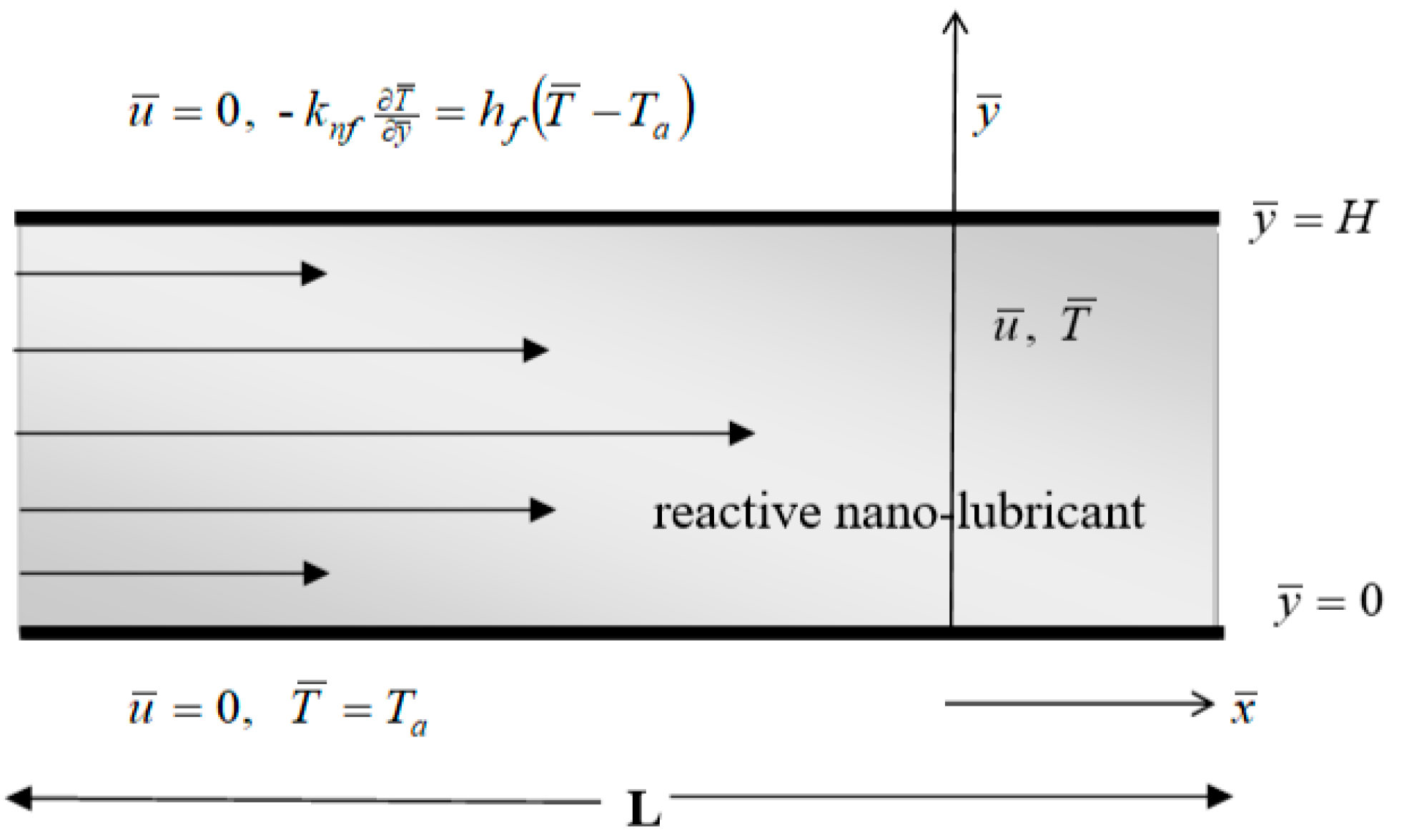
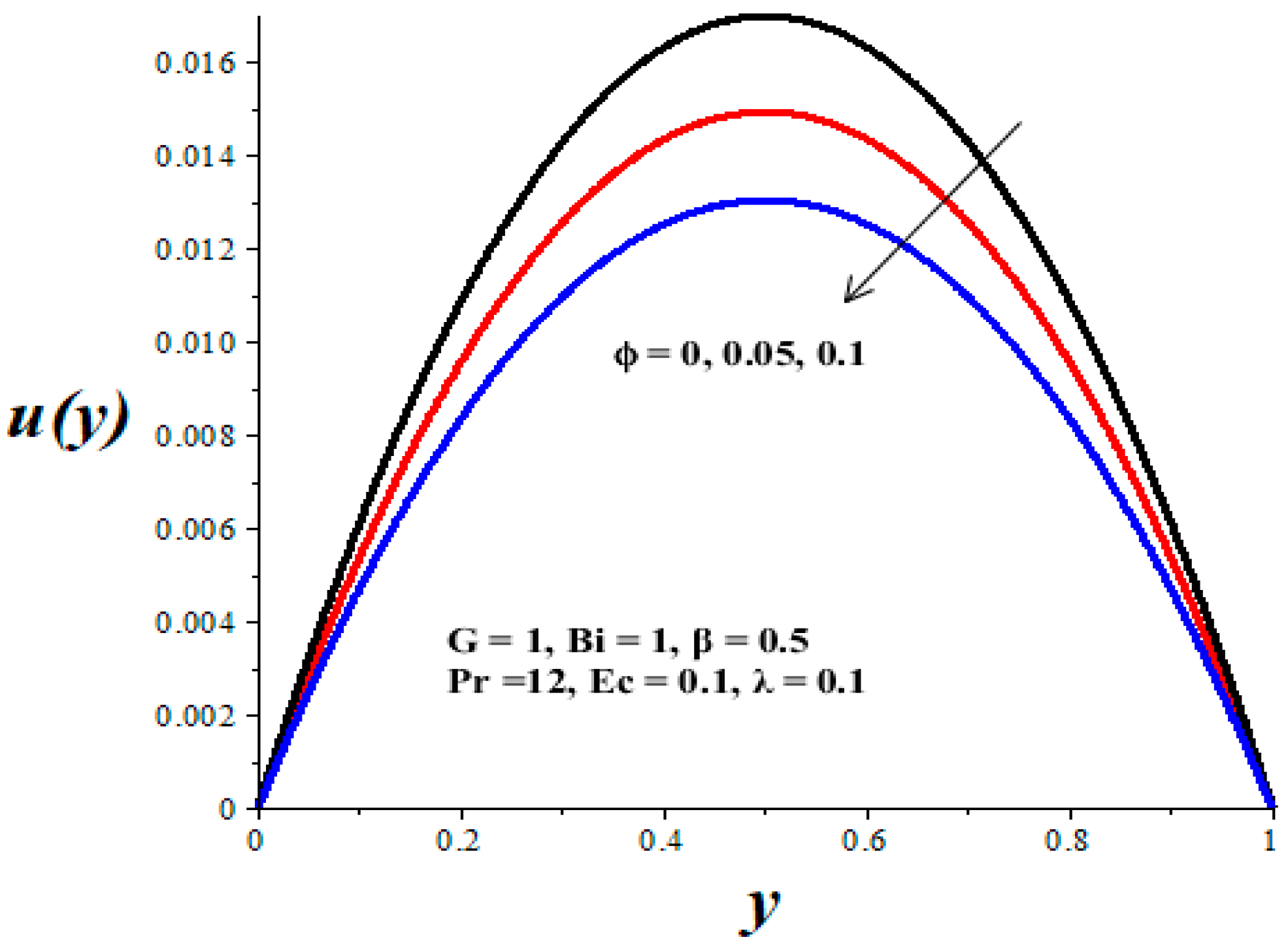
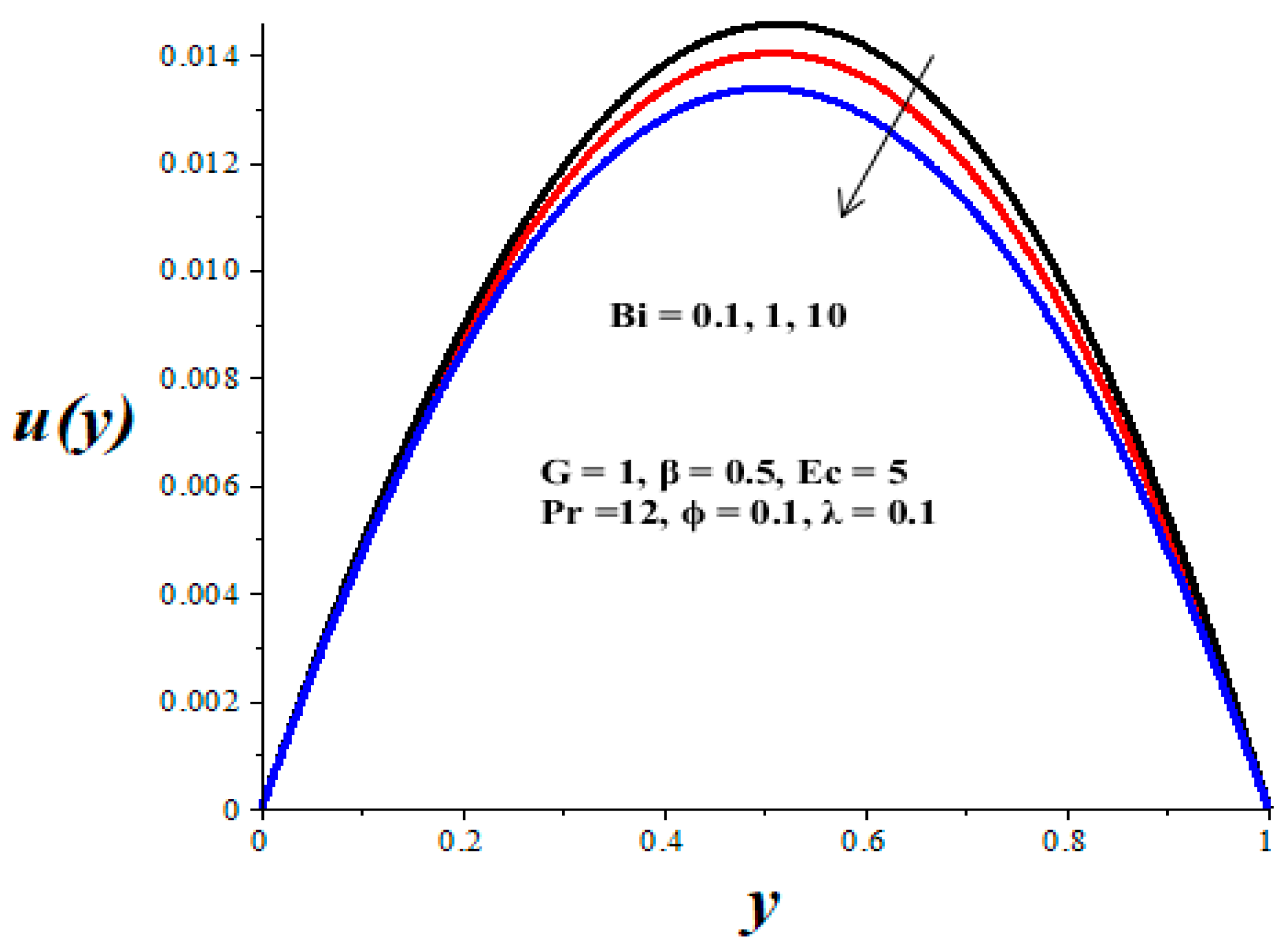

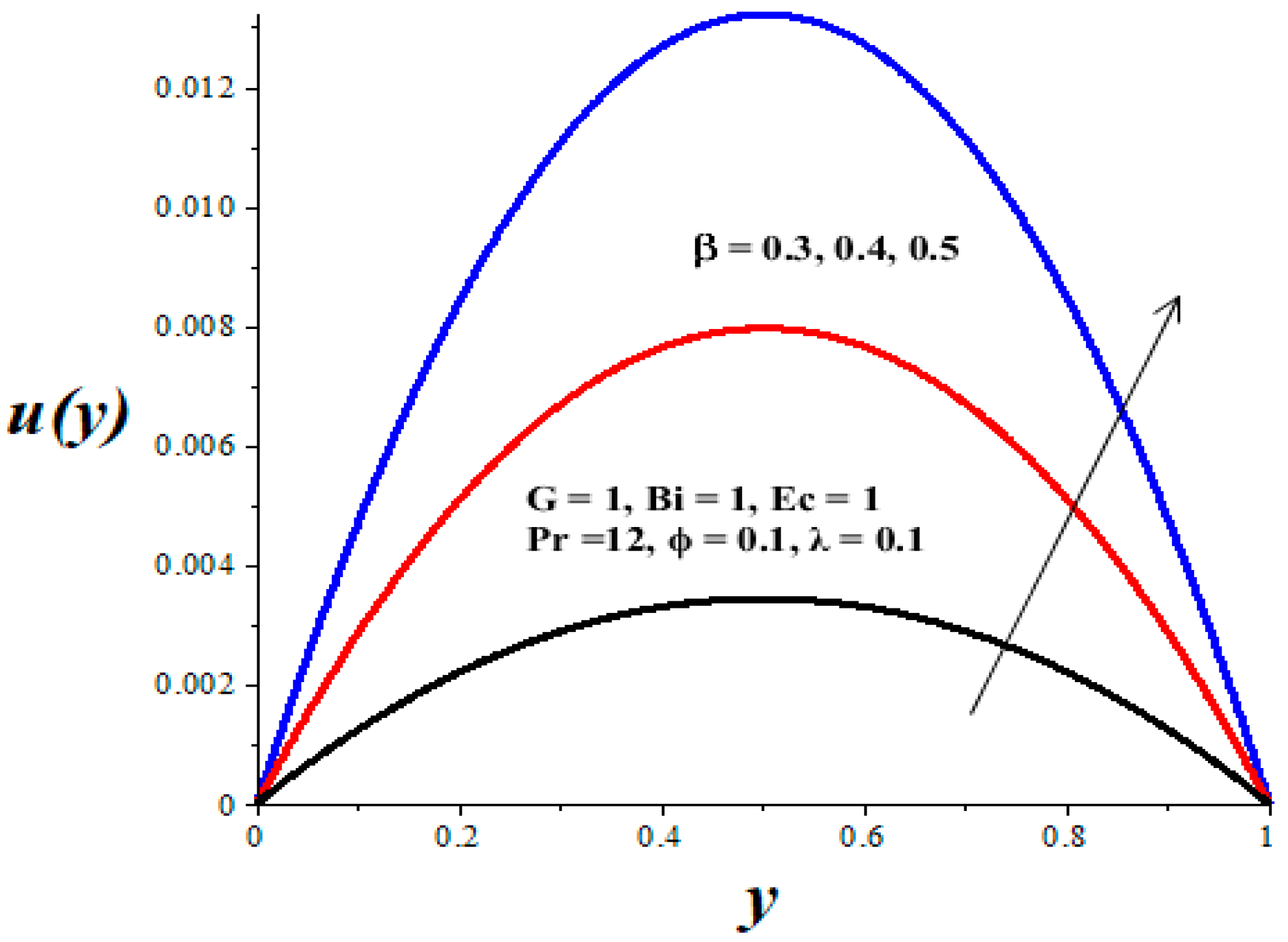
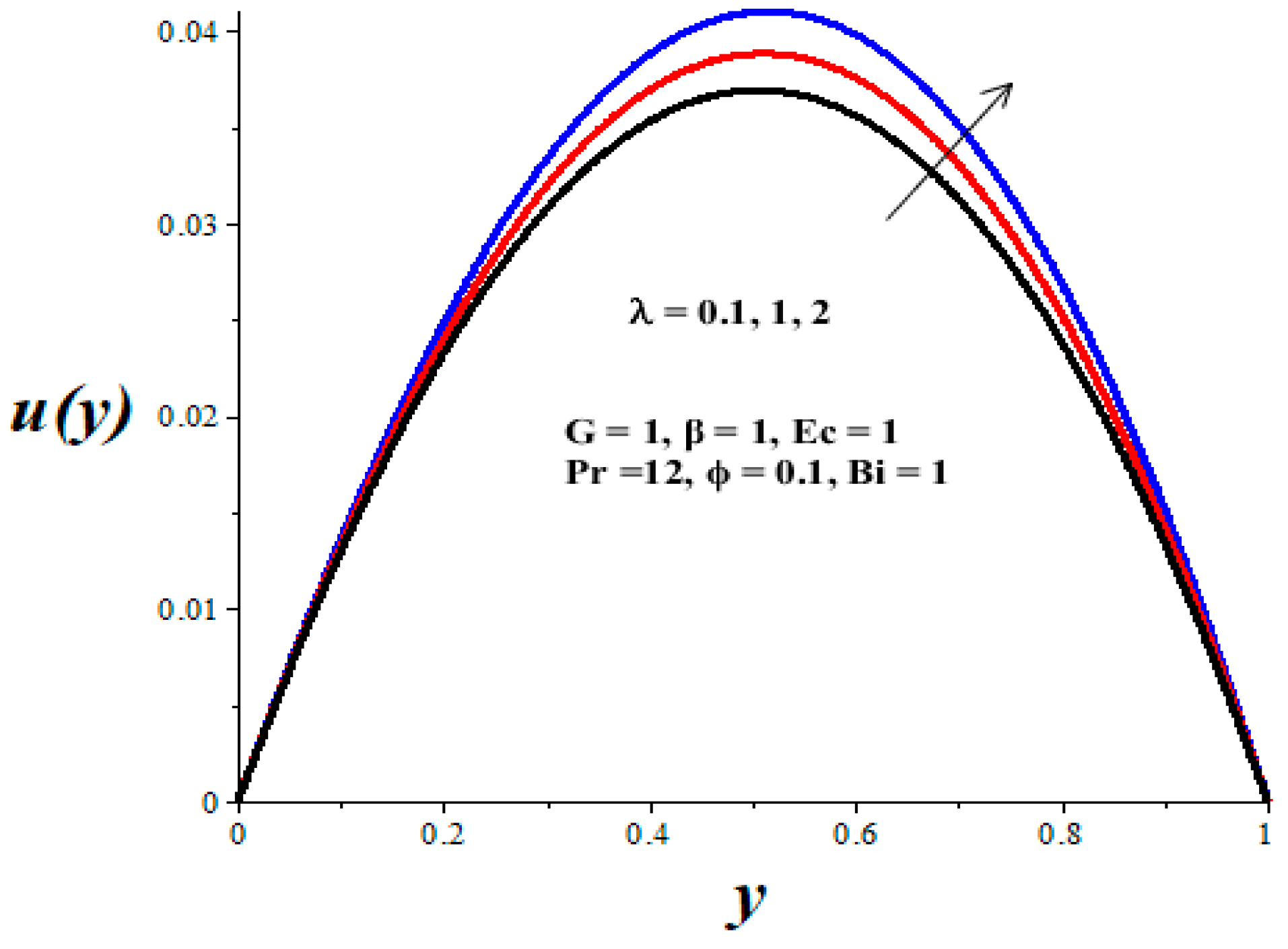
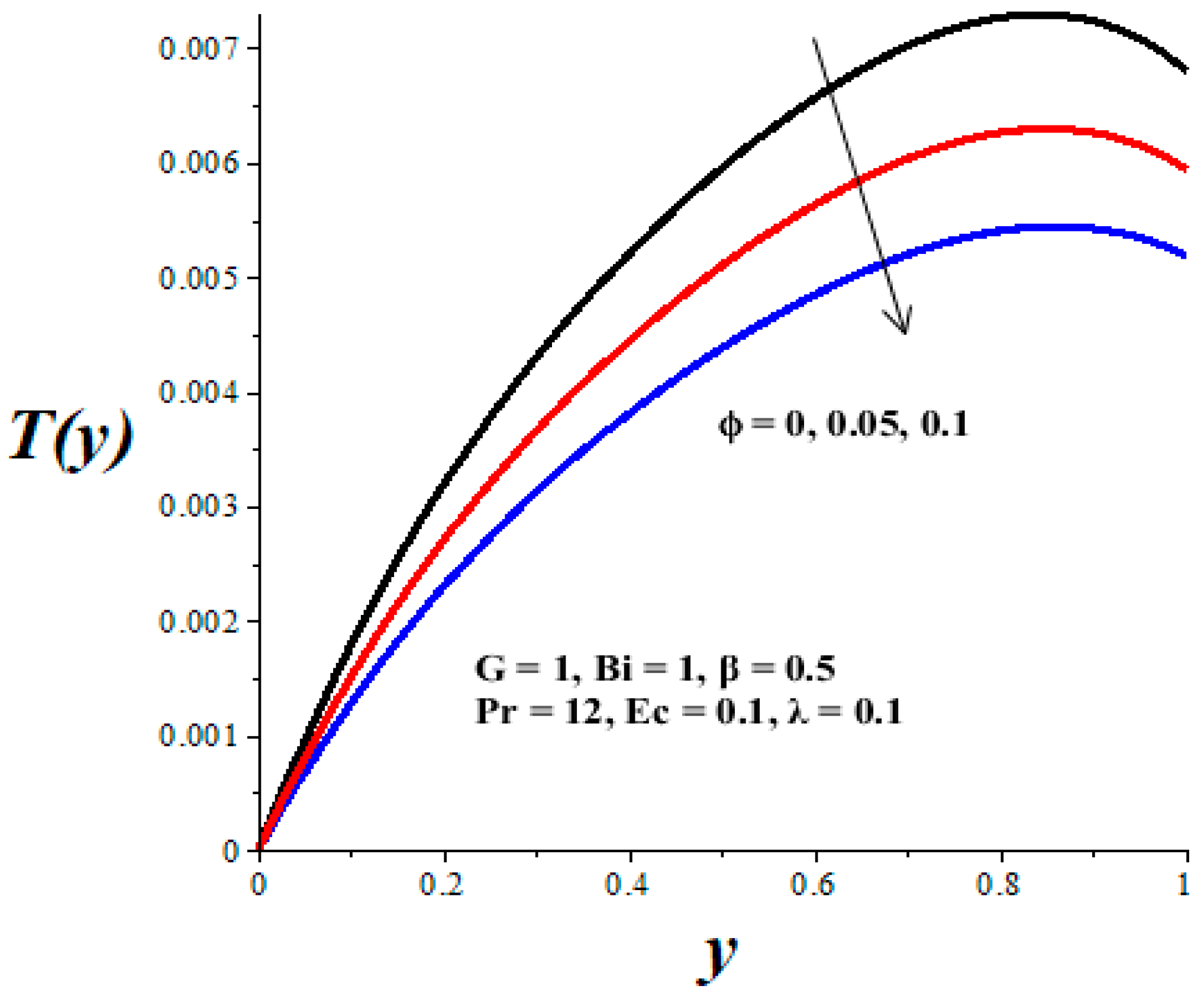
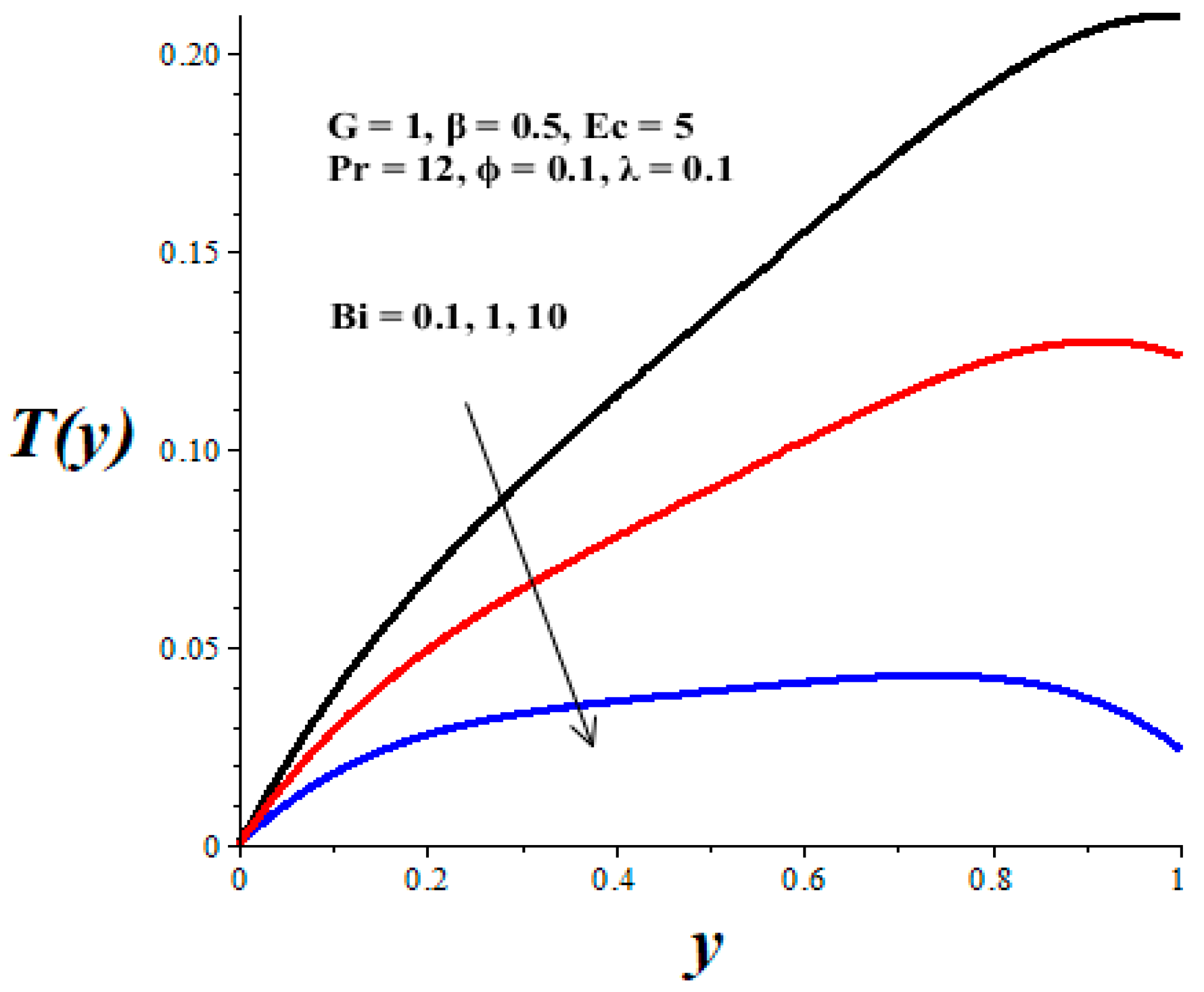
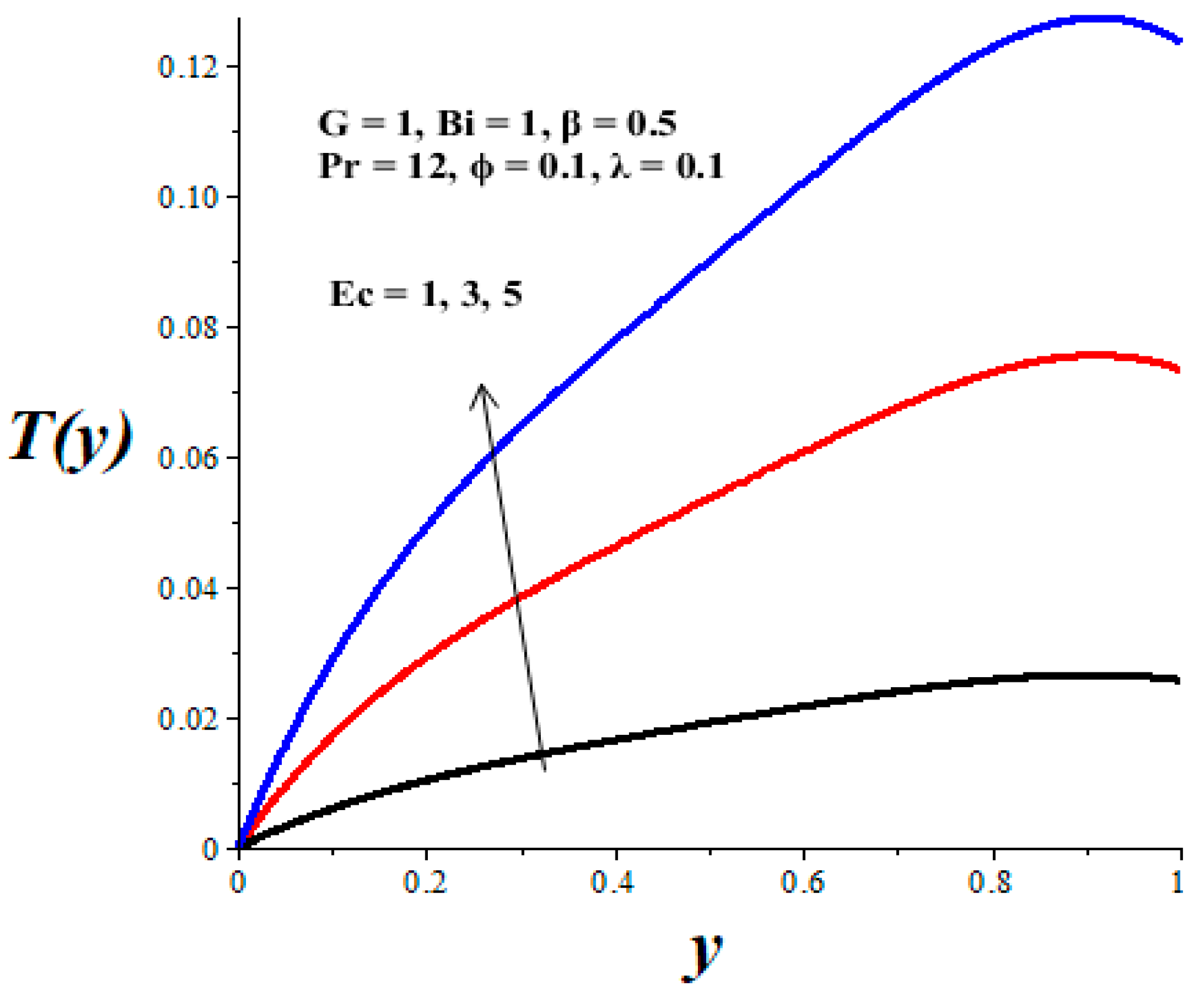
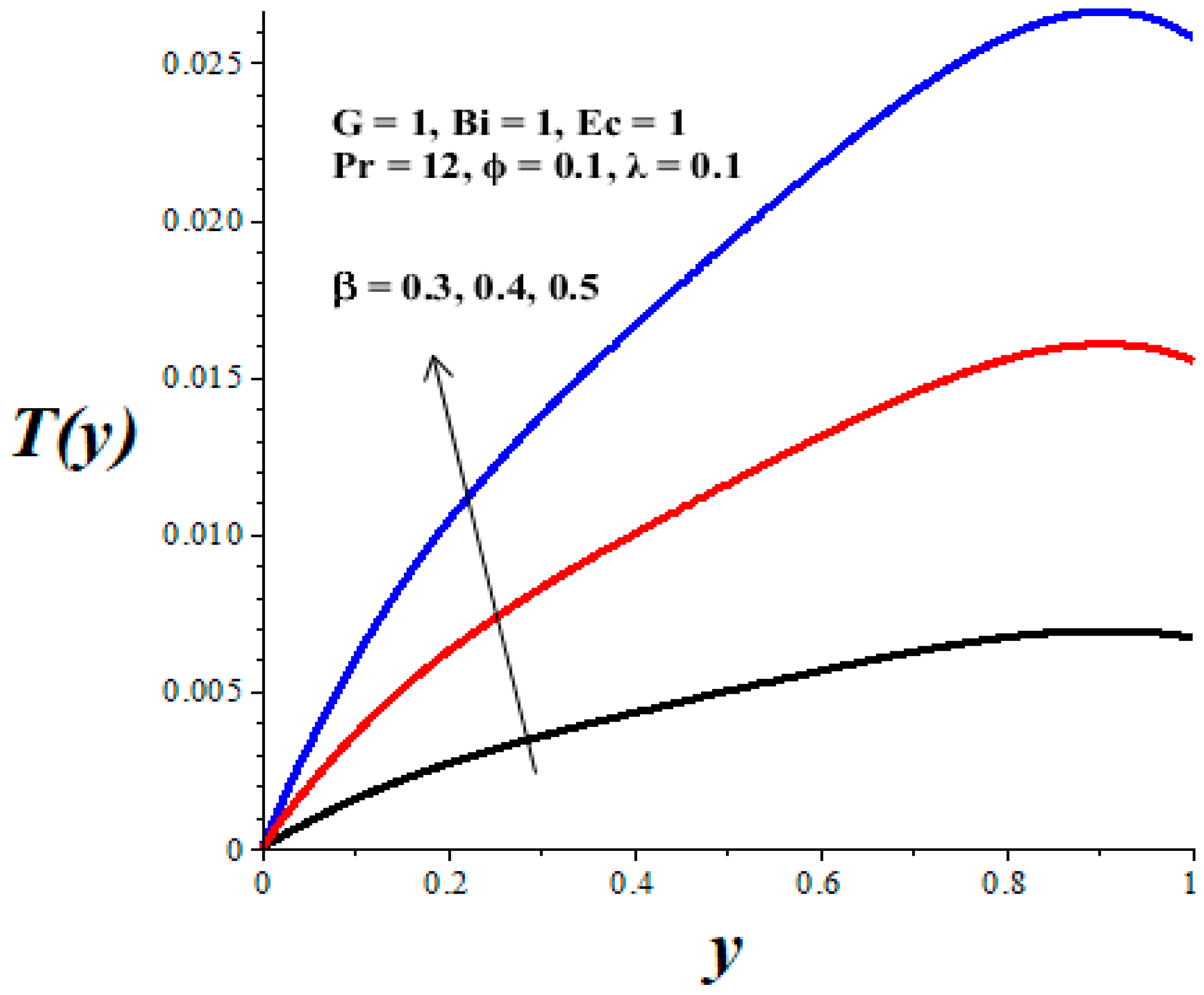
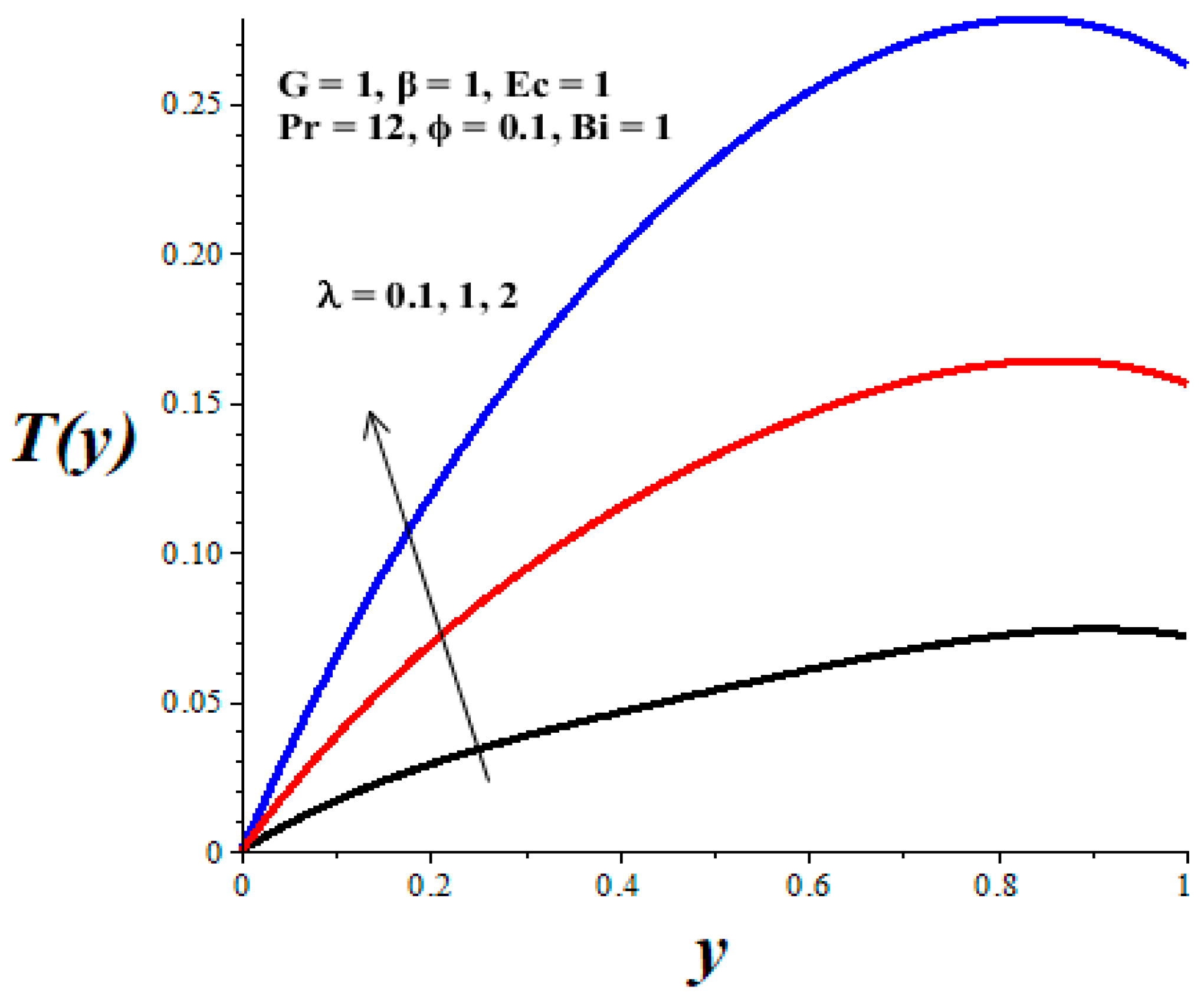
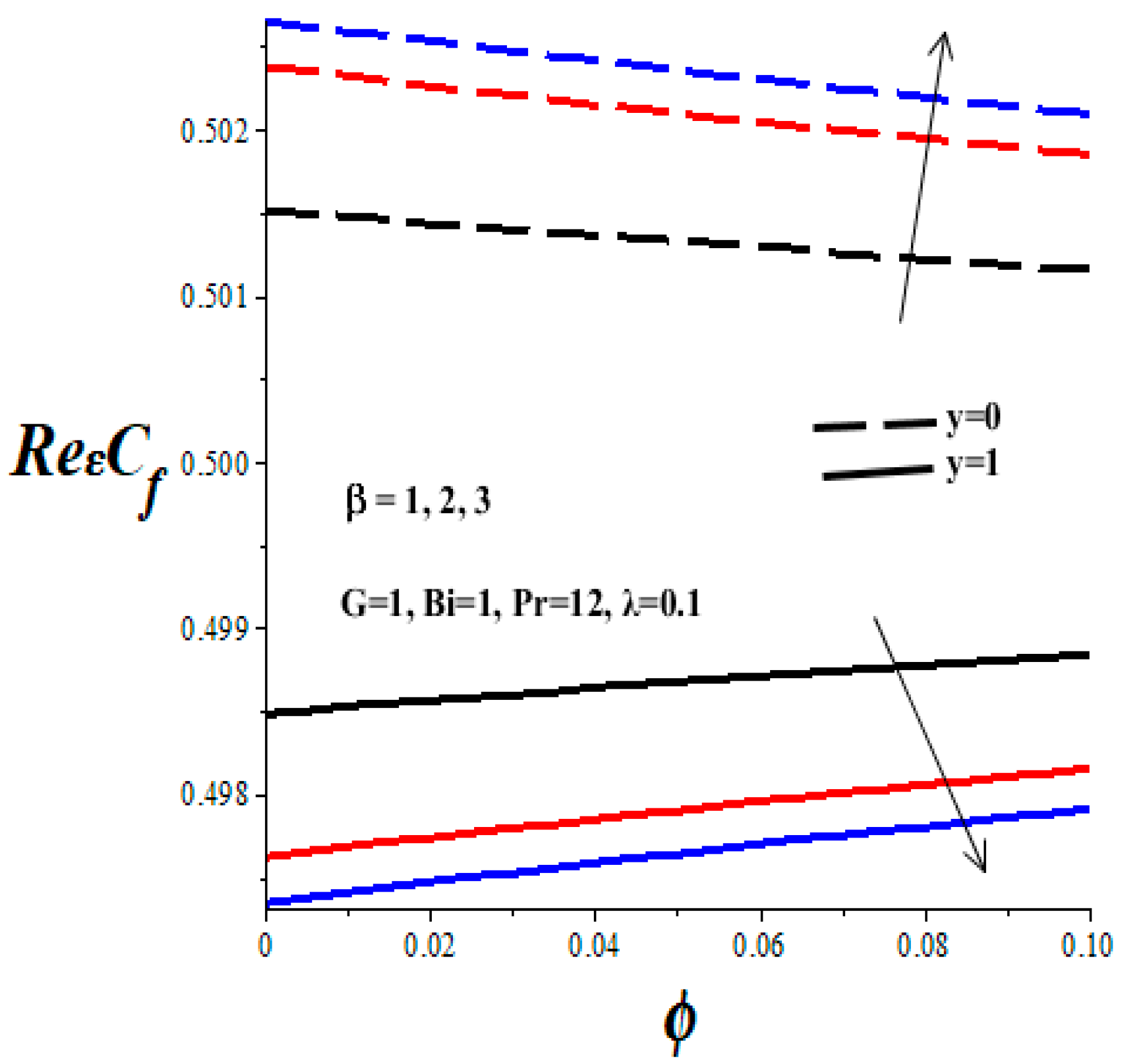


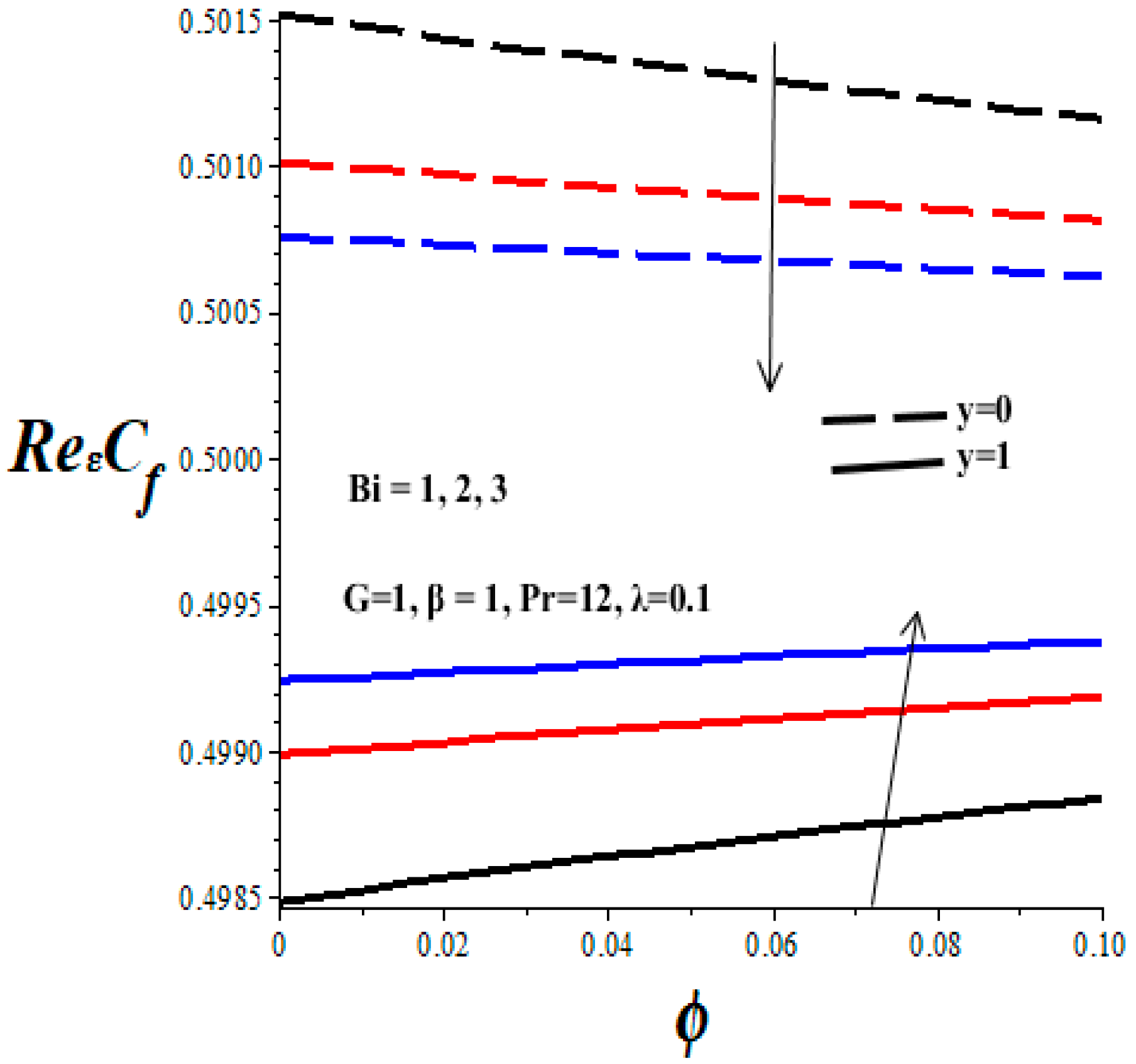


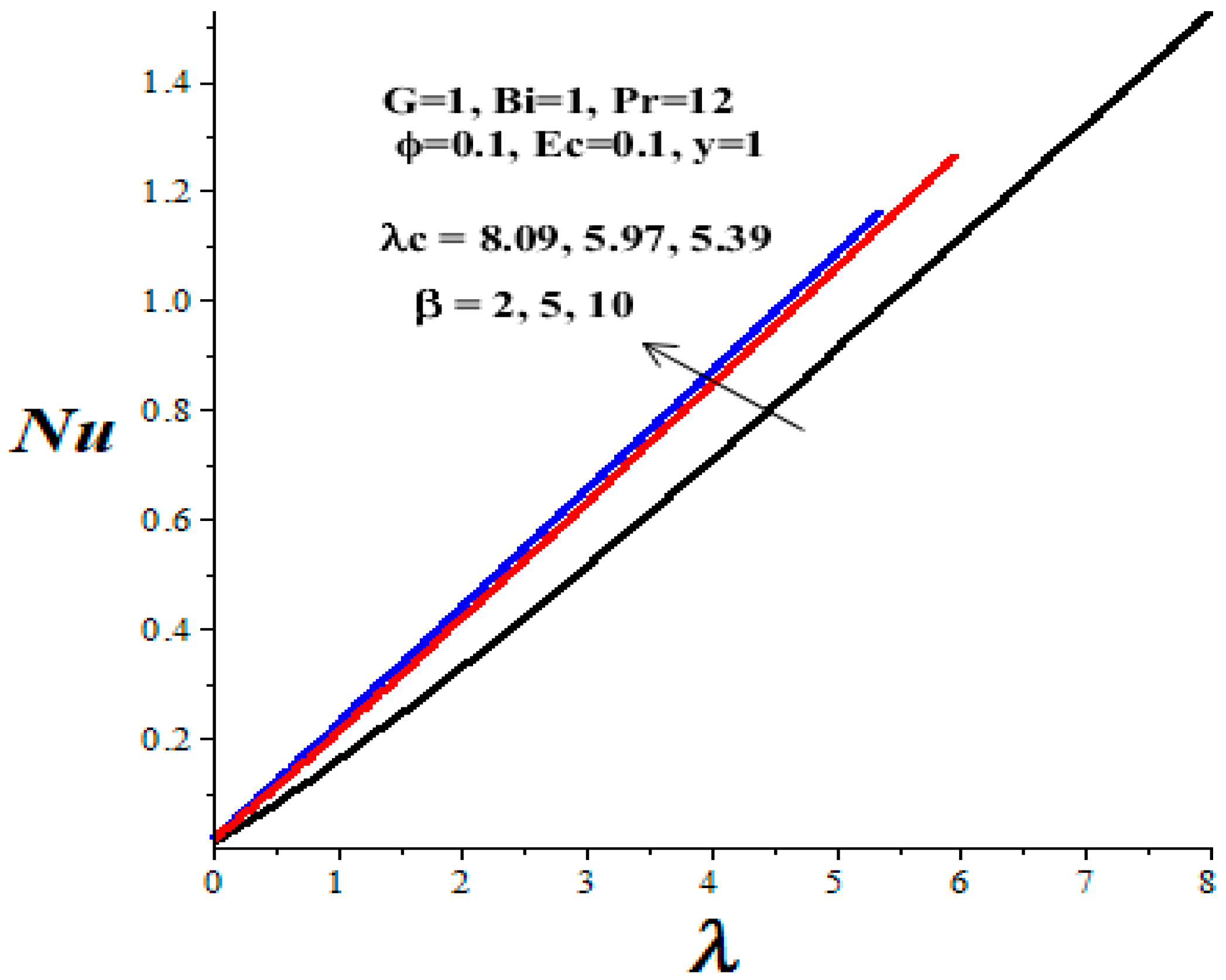
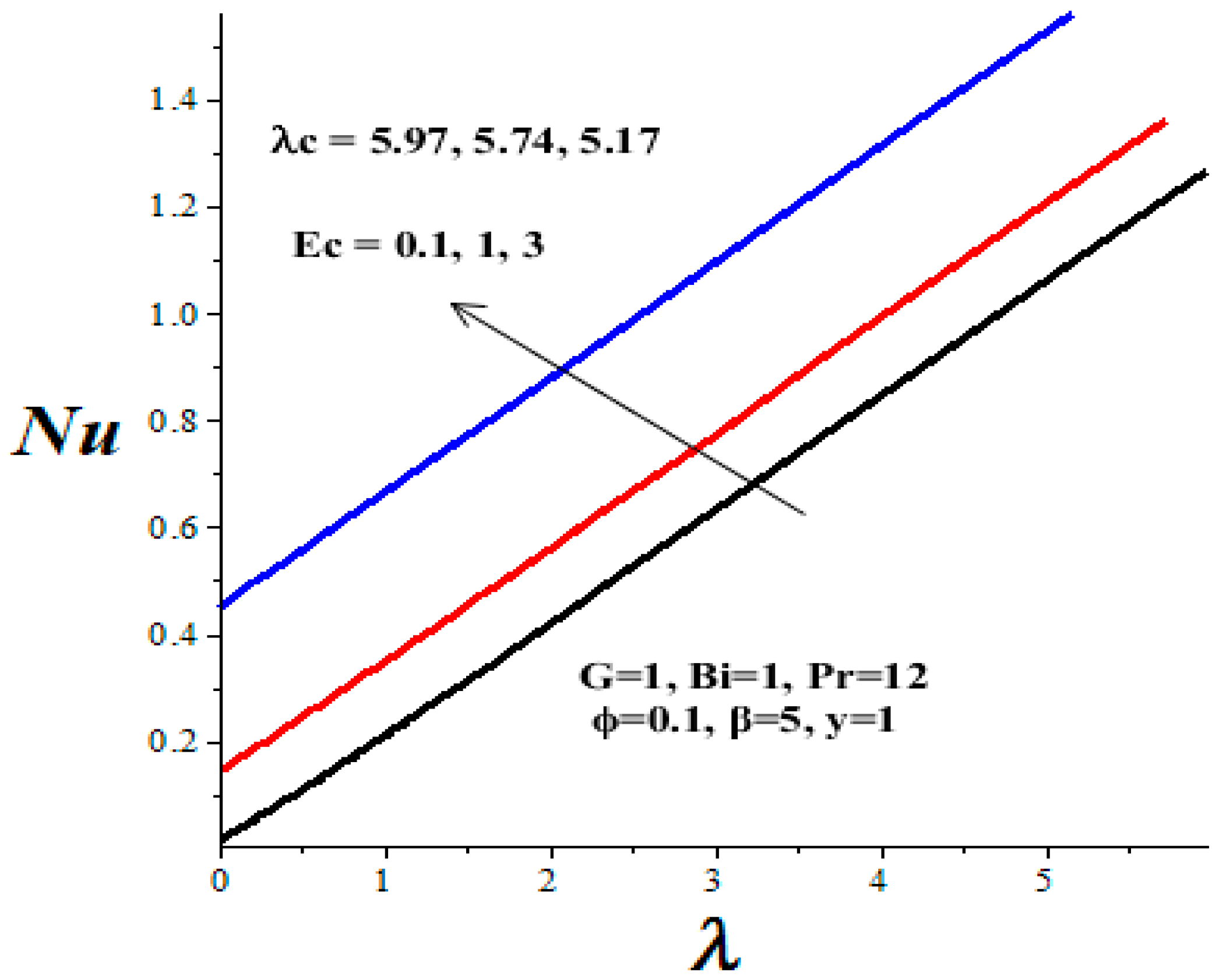
| Physical Properties | ρ (kg/m3) | Cp (J/kg·K) | k (W/m·K) |
|---|---|---|---|
| PAO | 798 | 2303 | 0.143 |
| TiO2 | 4010 | 690 | 8.7 |
| y | u(y) Exact | u(y) Numerical | T(y) Exact | T(y) Numerical |
|---|---|---|---|---|
| 0 | 0.00000000 | 0.0000000 | 0.0000000 | 0.0000000 |
| 0.1 | 0.03457950 | 0.03457951 | 0.0939346 | 0.0939347 |
| 0.2 | 0.06147467 | 0.06147468 | 0.1689389 | 0.1689390 |
| 0.3 | 0.08068551 | 0.08068551 | 0.2299185 | 0.2299186 |
| 0.4 | 0.09221201 | 0.09221202 | 0.2803778 | 0.2803778 |
| 0.5 | 0.09605418 | 0.09605418 | 0.3224191 | 0.3224192 |
| 0.6 | 0.09221201 | 0.09221202 | 0.3567434 | 0.3567435 |
| 0.7 | 0.08068551 | 0.08068551 | 0.3826498 | 0.3826499 |
| 0.8 | 0.06147467 | 0.06147468 | 0.3980358 | 0.3980358 |
| 0.9 | 0.03457950 | 0.03457951 | 0.3993972 | 0.3993973 |
| 1.0 | 0.00000000 | 0.00000000 | 0.3818282 | 0.3818282 |
| ϕ | β | Ec | Bi | λc |
|---|---|---|---|---|
| 0 | 5 | 0.1 | 1 | 4.95294 |
| 0.05 | 5 | 0.1 | 1 | 5.44322 |
| 0.1 | 5 | 0.1 | 1 | 5.97406 |
| 0.1 | 10 | 0.1 | 1 | 5.39884 |
| 0.1 | 2 | 0.1 | 1 | 8.09072 |
| 0.1 | 5 | 1 | 1 | 5.74703 |
| 0.1 | 5 | 3 | 1 | 5.17685 |
| 0.1 | 5 | 0.1 | 2 | 7.53357 |
| 0.1 | 5 | 0.1 | 3 | 8.71568 |
Disclaimer/Publisher’s Note: The statements, opinions and data contained in all publications are solely those of the individual author(s) and contributor(s) and not of MDPI and/or the editor(s). MDPI and/or the editor(s) disclaim responsibility for any injury to people or property resulting from any ideas, methods, instructions or products referred to in the content. |
© 2023 by the authors. Licensee MDPI, Basel, Switzerland. This article is an open access article distributed under the terms and conditions of the Creative Commons Attribution (CC BY) license (https://creativecommons.org/licenses/by/4.0/).
Share and Cite
Makinde, O.D.; Makinde, A.E. Thermal Analysis of a Reactive Variable Viscosity TiO2-PAO Nanolubricant in a Microchannel Poiseuille Flow. Micromachines 2023, 14, 1164. https://doi.org/10.3390/mi14061164
Makinde OD, Makinde AE. Thermal Analysis of a Reactive Variable Viscosity TiO2-PAO Nanolubricant in a Microchannel Poiseuille Flow. Micromachines. 2023; 14(6):1164. https://doi.org/10.3390/mi14061164
Chicago/Turabian StyleMakinde, Oluwole Daniel, and Anuoluwa Esther Makinde. 2023. "Thermal Analysis of a Reactive Variable Viscosity TiO2-PAO Nanolubricant in a Microchannel Poiseuille Flow" Micromachines 14, no. 6: 1164. https://doi.org/10.3390/mi14061164






